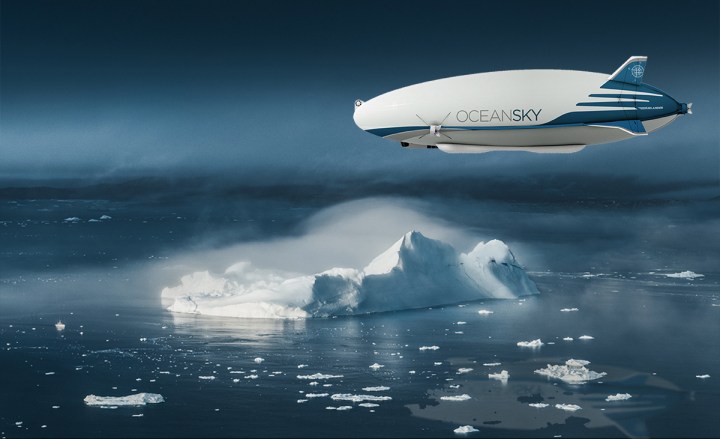
Picture it: Dancing the night away with cocktails in hand, fresh air breezing over your skin as you step out onto a quiet balcony. Below, lights from small towns dot Earth’s darkened landscape as you pass overhead, the moon reflected in an inky lake.
This is how air travel once was aboard passenger airships — and how it could be again, if airships continue on the promising path they’ve been sailing the past decade.
Like other new technology, passenger airship voyages won’t be cheap at first. It’s a cool $65K to secure a cabin-for-two aboard OceanSky Cruises’ maiden voyage to the North Pole, set for 2023-2024.
But there’s a market for adventure-seeking passengers who are looking for a sustainable and eco-friendly way to travel, said Carl-Oscar Lawaczeck, OceanSky Cruises’ CEO.
“They are the ones who want to have the bragging rights of doing something first before anyone else,” Lawaczeck told Digital Trends.
Back to the future
Airships predated airplanes by a few decades; the first airship successfully took to the skies in France in 1852. After years of use in war as reconnaissance and bombing tools, an airship made the first nonstop transatlantic flight in 1919, nearly a decade before Charles Lindburgh flew across in 1928.
1928 was also the first year that airship passenger flight began, and it was popular enough that when the Empire State Building was completed in 1931 it included an airship mast. Airships could carry more passengers than planes, and were far more comfortable, with dining rooms, observation decks, and private cabins, more like a cruise ship (but faster). By the mid 1930s there were regular flights from Germany to Brazil, and by 1936 a full season of flights between Germany and New Jersey further legitimized airship travel.

In 1937, the Hindenburg disaster, which was filmed and distributed via newsreels, cooled the public trust of airships at the same time plane flight was becoming more accessible.
Airships today aren’t the same as blimps but they are all dirigibles, meaning they’re all powered and steerable.
Some airships have rigid structures, semi-rigid structures or no internal structure (that’s a blimp) and they can use either hydrogen or helium for lift. Both elements are lighter than air, requiring no energy to rise up into the sky—though some kind of fuel is needed to move horizontally. This can be electric power from renewable energy, so carbon-free transport is possible.
The free vertical lift via lighter-than-air gases makes airships much more efficient than planes, which need fossil fuel for lift and acceleration. Helium is currently the preferred lifting agent as hydrogen can be flammable, though a lot less likely to explode—the issue in the Hindenburg disaster 100 years ago—considering new technology and materials. Once an airship is filled with helium or hydrogen, it doesn’t need “refueling”—the same volume of gas can be used for multiple journeys.
Airships are making a cargo-first comeback
The airship revival that’s already well underway has thus far focused on cargo. This makes sense considering many companies and governments are looking to reduce carbon, while still transporting goods globally.
“We know that carbon taxes will be increasing and the jets are extremely polluting,” said Barry Prentice, President of Canada-based Buoyant Aircraft Systems International, an airship company. “Hence the cost advantage of airships should increase,”
Airships are about five times slower than planes, but most internationally shipped goods don’t need to be transported overnight in a fast, carbon-spewing plane to languish in a warehouse. That’s just a waste of fossil fuels, Prentice told Digital Trends. In fact, much of the world’s cargo already travels slowly on ocean-going shipping vessels.
Airships have other huge advantages for cargo: They can also take loads that are outside container-size dimensions, and they aren’t limited to the same busy, often-backed-up ports that ships are.

They can take off and land from roadless, runway-less locations such as a beach, field, or even ice. That creates a huge advantage for delivering vital equipment to remote or hard-to-reach areas, Prentice said.
That makes airships ideal for transporting large earth-moving equipment, water, and bulky supplies to an area that’s experienced a natural disaster when roads are underwater or destroyed. Prentice wants to see airships used to transport pre-built structures for schools and housing to less-accessible places, like areas of northern Canada not connected by roads.
Some of these advantages for cargo may also make airships exciting from a traveler’s perspective.
Travelers who aren’t dependent on airports or ports could go to a variety of new, far-flung destinations airship advocates believe. Islands with little or no infrastructure could be easily accessed, deserts and other forbidding-but-beautiful landscapes could be seen up close in comfort, and features like dunes and canyons viewed from new perspectives.
“When we provide a transportation mode that gives access to untouched nature, we have to do that with responsibility and respect”
“Flying above the Amazonian forest canopy could also be a great experience to observe the wildlife with a very limited disturbance,” said Pierre-Yves Fouillen, marketing manager of French airship company Flying Whales.
If you’re worried about the potential impact of airship tourism on these places, OceanSky Cruises’ Lawaczeck is way ahead of you. Having to build roads to access remote destinations can be devastating to the local ecosystem. Airships would remove the need for such invasive construction.
“When we provide a transportation mode that gives access to untouched nature, we have to do that with responsibility and respect,” he said.
What will airship travel look like?
The gondola hangs underneath an airship’s helium-filled balloon and comprises cargo or passenger space. It can be designed as a huge open hold for large earthmoving equipment or divided up into passenger spaces, so its totally customizable.
Since airships move and land slower, at 20 knots compared to planes’ 100 knots, airship designers don’t have to design to withstand 40 Gs—just 4Gs. “Everything is lighter and cheaper and easier and that gives a lot of possibilities. So you can do a lot more than an airplane,” says Lawaczeck.
Ocean Sky Cruises is eschewing the “gold and leather” look for something that nods to aviation history. ”The possibilities are amazing when you compare airships with planes—they’re non pressurized because you fly low which means you can make the big windows, put in glass floors, and more,” says Lawaczeck.
Like a gorgeous dining room with changing views, an observation area with information about the animal herds you’re flying over, or even a dance floor, a cocktail bar, and a cozy bed to fall into at the end of the night.
Like all new tech, airship travel will at first be expensive and exclusive. So like the first space tourists, the first passenger airship cruisers will do it for the unique experience and bragging rights.
Bridging the gap between commercialization and tech development to help make airship travel a reality is part of what OceanSky aims to do, Lawaczeck said.
Because of their carrying capacity, the next airship travelers after the very wealthy could be groups. Conferences, scientific expeditions, educational organizations, and other groups might find airships convenient — they can both bring needed equipment with them and utilize time flying for work or education. Eventually, airship experts agree that passenger service will be more affordable.

The challenges to airship travel
Long-term, airship travel will be cheaper than plane travel. While the new tech makes them expensive to build now, airships are fundamentally simpler machines than planes. Once scaled, they’ll be cheaper and easier to build and maintain. “The complexity of an airship is much lower. An airplane has landing gear that has to move in and out during flight, which puts an extreme amount of wear and tear and stress on the hull and landing gear, so there’s three redundant hydraulic systems,” says Lawaczeck. There are similar safety systems for wings and the other airplane gear on planes in order to take off, land, and fly safely.
Simpler is cheaper. Further driving costs down, airships will be able to carry much larger loads than planes—think 1,000 passengers (with plenty of room for the stuff they want to take along, too). Or more: “We don’t know the upper limits on airship size,” Prentice says. He says that in the past the German Zeppelins could lift about 70 megatons (MT). “With today’s materials and engineering, we could be much larger, certainly something in the 250 MT range seems possible.”
Not only will airships outcompete jet travel, they’ll do it with far fewer CO2 emissions. “I know that [airships] will be a mass-market product at some point,” says Lawaczeck.
All that stands in the way at this point is flight regulations. In the U.S. the FAA makes the rules for airship travel, including certification of parts, maintenance requirements, and operation and flight rules. Bob Boyd, the program manager for Lockheed Martin’s hybrid airships program says they’ve been working with the FAA on rules for cargo flights and predicts in another 2-3 years those will be ironed out. Lockheed is already taking orders.
In 1929, the Graf Zeppelin’s captain had to admonish his too-loud, hard-partying passengers as they glided over Siberia. It’s very possible that by 2029 some of us could be raging in the skies once again.
Editors' Recommendations
- The future of making stuff: Inside the evolution of 3D printing with Formlabs
- 3D printing lets hospitals make ventilator substitutes with common equipment
- Get off the sidewalk! Lime’s new scooter aims to make you ride on the road
- Make a wish upon a star: Here’s how to watch this week’s Orionid meteor shower
- Zeppelins could make a comeback with this solar-powered airship cargo mover




